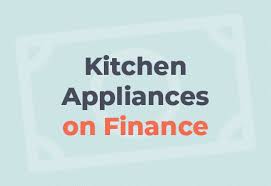In today’s modern homes, kitchen appliances are not just conveniences; they’re necessities. From energy-efficient refrigerators to smart ovens, these appliances can significantly improve our quality of life. However, the cost of outfitting a kitchen with high-quality appliances can be substantial, often running into thousands of dollars. This comprehensive guide will explore various strategies for financing kitchen appliances, helping you make informed decisions that align with your budget and needs. Whether you’re renovating your kitchen, replacing old appliances, or setting up your first home, this article will provide you with valuable insights into the world of kitchen appliance financing.
Understanding the Cost of Kitchen Appliances
Before diving into financing options, it’s crucial to understand the typical costs associated with kitchen appliances. This knowledge will help you set realistic budgets and determine how much financing you might need.
Common Kitchen Appliances and Their Average Costs
- Refrigerators:
- Basic models: $500 – $1,000
- Mid-range models: $1,000 – $3,000
- High-end models: $3,000 – $10,000+
- Ovens and Ranges:
- Basic models: $400 – $600
- Mid-range models: $600 – $2,000
- High-end models: $2,000 – $5,000+
- Dishwashers:
- Basic models: $300 – $500
- Mid-range models: $500 – $1,000
- High-end models: $1,000 – $2,000+
- Microwaves:
- Countertop models: $50 – $200
- Built-in models: $200 – $1,000+
- Range Hoods:
- Basic models: $50 – $200
- Mid-range models: $200 – $500
- High-end models: $500 – $1,000+
These prices can vary based on factors such as brand, features, energy efficiency, and whether the appliances are “smart” or connected.
Factors Affecting Appliance Costs
Several factors can influence the cost of kitchen appliances:
- Brand: Well-known, premium brands often come with higher price tags.
- Features: Advanced features like smart connectivity or specialized cooking modes can increase costs.
- Energy Efficiency: While more energy-efficient models may cost more upfront, they can lead to savings on utility bills over time.
- Size and Capacity: Larger appliances or those with greater capacity typically cost more.
- Finish: Stainless steel or custom finishes usually cost more than standard white or black appliances.
Understanding these factors can help you prioritize what’s most important to you when selecting appliances and determining your financing needs.
Fact: According to a 2021 study by HomeAdvisor, the average cost to outfit a kitchen with new appliances ranges from $1,900 to $6,500, with an average of around $4,200.
Assessing Your Financial Situation
Before exploring financing options for kitchen appliances, it’s essential to evaluate your current financial standing. This assessment will help you determine which financing methods are most suitable for your situation.
Steps to Assess Your Finances
- Check Your Credit Score:
- Obtain your free credit report from AnnualCreditReport.com
- Review for errors and dispute any inaccuracies
- Understand how your score impacts loan options and interest rates
- Calculate Your Debt-to-Income Ratio (DTI):
- Add up all monthly debt payments
- Divide by your gross monthly income
- Multiply by 100 to get your DTI percentage
- Aim for a DTI below 43% for better loan options
- Evaluate Your Savings:
- Determine how much you can contribute as a down payment
- Consider setting aside funds for unexpected costs
- Create a Realistic Budget:
- Factor in all costs associated with new appliances (delivery, installation, etc.)
- Include a buffer for unforeseen expenses (typically 10-20% of the total budget)
- Determine Your Monthly Payment Comfort Zone:
- Calculate how much you can comfortably afford to pay each month
- Consider potential changes in income or expenses over the loan term
By thoroughly assessing your financial situation, you’ll be better equipped to choose a financing option that aligns with your budget and long-term financial goals.
Case Study: The Impact of Credit Scores on Financing Sarah and Mike, a couple renovating their kitchen, both applied for appliance financing. Sarah, with a credit score of 750, qualified for a 24-month 0% APR offer. Mike, with a score of 650, was offered a 24-month plan with a 15% APR. On a $5,000 appliance package, Mike would end up paying over $800 more in interest than Sarah over the life of the loan. This example illustrates the significant impact credit scores can have on financing terms and overall costs.
Exploring Financing Options for Kitchen Appliances
When it comes to financing kitchen appliances, there are several options available, each with its own advantages and considerations. Let’s explore these options in detail.
Store Financing
Many appliance retailers offer their own financing programs, often through partnerships with banks or financial institutions.
Pros:
- Convenience of one-stop shopping
- Special promotions like 0% APR for a limited time
- Potential for instant approval in-store
Cons:
- May have higher interest rates after promotional periods
- Could be limited to specific brands or models
- Might require opening a new credit account
Example Terms:
- 0% APR for 12-24 months on purchases over $999
- No interest if paid in full within promotional period
- Regular APR of 15-25% applies after promotional period
Tip: Always read the fine print carefully, especially regarding what happens if you don’t pay off the balance within the promotional period.
Credit Cards
Using a credit card, especially one with a 0% APR introductory offer, can be an effective way to finance kitchen appliances.
Pros:
- Potential for rewards or cashback
- Flexibility to use across different stores
- Consumer protections offered by credit card companies
Cons:
- May have high interest rates after introductory periods
- Could impact your credit utilization ratio
- Temptation to overspend
Strategy:
- Look for cards with 0% APR on purchases for 12-18 months
- Calculate if you can pay off the balance before the promotional period ends
- Consider balance transfer options if needed
Quote from Financial Advisor: “Credit cards can be a smart way to finance appliances if you have a solid plan to pay off the balance before any interest kicks in. It’s all about discipline and budgeting.” – John Smith, Certified Financial Planner
Personal Loans
Personal loans from banks, credit unions, or online lenders can provide a structured way to finance kitchen appliances.
Pros:
- Fixed interest rates and repayment terms
- Can be used for multiple purchases or to cover additional costs
- No collateral required (for unsecured loans)
Cons:
- May have higher interest rates than secured loans
- Approval and rates heavily dependent on credit score
- Potential for origination fees
Key Considerations:
- Compare offers from multiple lenders
- Look at the total cost of the loan, not just monthly payments
- Check for any prepayment penalties
Fact: According to Experian, the average personal loan interest rate in 2021 ranged from 9.58% to 21.47%, depending on credit score.
Home Equity Loans or Lines of Credit
For homeowners with significant equity, using a home equity loan or line of credit can be an option for financing kitchen appliances.
Pros:
- Generally lower interest rates than unsecured loans or credit cards
- Interest may be tax-deductible (consult a tax professional)
- Can be used for other home improvement projects as well
Cons:
- Puts your home at risk if you default on payments
- May have closing costs and fees
- Lengthy application and approval process
Considerations:
- Typically requires at least 15-20% equity in your home
- Consider the long-term impact on your home equity
- Compare with other financing options to ensure it’s cost-effective for your situation
Buy Now, Pay Later Services
Increasingly popular, these services offer short-term financing options at the point of sale.
Popular Services:
- Affirm
- Klarna
- Afterpay
How They Work:
- Split the cost into fixed monthly payments
- Often offer 0% APR for short terms (3-6 months)
- Quick approval process, often with a soft credit check
Pros:
- Easy to qualify for, even with less-than-perfect credit
- Transparent payment terms
- No interest if paid off within the agreed term (for some offers)
Cons:
- Can encourage overspending
- May have high interest rates for longer terms
- Missed payments can significantly impact credit score
Case Study: The Rise of Buy Now, Pay Later In 2020, the use of Buy Now, Pay Later services for home goods and appliances increased by 46% compared to the previous year, according to a report by Worldpay. This trend indicates a growing preference for flexible, short-term financing options among consumers.
Strategies for Smart Appliance Financing
Regardless of which financing option you choose, implementing smart strategies can help you get the most value for your money when financing kitchen appliances.
Timing Your Purchase
Take advantage of seasonal sales and promotions to maximize your budget.
Best Times to Buy:
- September and October: New models are released, leading to discounts on older models
- Black Friday and Cyber Monday: Major appliance sales events
- January: Post-holiday sales and inventory clearance
- Memorial Day, Labor Day, and Fourth of July: Holiday weekend sales
Tip: Sign up for newsletters from appliance retailers to stay informed about upcoming sales and exclusive offers.
Bundle Deals and Package Discounts
Purchasing multiple appliances together can often lead to significant savings.
Strategy:
- Look for package deals on full kitchen appliance sets
- Ask retailers about additional discounts for buying multiple items
- Consider if bundled warranties or service plans offer good value
Example Savings: A major retailer offered a package deal on a refrigerator, range, dishwasher, and microwave for $3,999, representing a savings of $1,200 compared to buying each item separately.
Negotiate and Price Match
Don’t be afraid to negotiate prices, especially for large appliance purchases.
Negotiation Tips:
- Research prices across multiple retailers
- Ask about price matching policies
- Inquire about floor models or open-box items for additional discounts
- See if the retailer will throw in free delivery or installation
Quote from Retail Expert: “Many consumers don’t realize that appliance prices are often negotiable, especially in local or independent stores. It never hurts to ask for a better deal, especially if you’re buying multiple items.” – Sarah Johnson, Appliance Retail Consultant
Consider Energy Efficiency
While energy-efficient appliances may have higher upfront costs, they can lead to significant savings over time.
Benefits of Energy-Efficient Appliances:
- Lower utility bills
- Potential tax credits or rebates
- Reduced environmental impact
Fact: According to ENERGY STAR, a certified refrigerator uses about 15% less energy than non-certified models, which can translate to over $200 in energy cost savings over the appliance’s lifetime.
Extended Warranties and Protection Plans
Carefully evaluate whether extended warranties or protection plans are worth the additional cost.
Considerations:
- Compare the cost of the warranty to the potential repair costs
- Check what’s covered under the manufacturer’s warranty
- Consider the reliability of the brand and model
Tip: Instead of purchasing extended warranties, consider setting aside the equivalent amount in a savings account for potential future repairs.
Managing Your Appliance Financing
Once you’ve secured financing for your kitchen appliances, it’s crucial to manage the loan or credit line effectively to maintain your financial health.
Creating a Repayment Plan
Develop a solid strategy for repaying your appliance financing to avoid financial stress and potential credit damage.
Steps to Create a Repayment Plan:
- Review your loan terms, including interest rate, monthly payment, and loan duration
- Incorporate the monthly payment into your household budget
- Set up automatic payments to ensure timely repayment
- Consider making extra payments when possible to reduce interest and pay off the loan faster
- Create a contingency plan for handling payments in case of unexpected financial challenges
Tip: Use online loan calculators to see how extra payments can impact your loan term and total interest paid.
Monitoring Your Credit
Keep a close eye on your credit report and score throughout the financing process and repayment period.
Why It’s Important:
- Detect any errors or fraudulent activity quickly
- Understand how the new account impacts your overall credit profile
- Identify opportunities for improving your credit score
How to Monitor Your Credit:
- Use free credit monitoring services offered by many credit card companies
- Check your credit reports annually at AnnualCreditReport.com
- Consider a paid credit monitoring service for more frequent updates and alerts
Fact: According to a Federal Trade Commission study, 1 in 5 consumers had an error on at least one of their credit reports that was corrected after disputing it.
Avoiding Common Financing Pitfalls
Be aware of potential pitfalls that can derail your appliance financing and overall financial health.
Common Pitfalls to Avoid:
- Overextending Your Budget:
- Stick to your predetermined budget, even if tempted by upgrades
- Include a buffer for unexpected costs
- Ignoring the Fine Print:
- Carefully read all loan documents before signing
- Pay attention to interest rates, fees, and prepayment penalties
- Neglecting Other Financial Goals:
- Balance appliance financing with other financial priorities (e.g., emergency fund, retirement savings)
- Avoid diverting funds from essential expenses to pay for appliances
- Failing to Plan for the Entire Project:
- Consider all aspects of a kitchen renovation, not just appliances
- Ensure your financing covers the entire scope of the project
Quote from Financial Advisor: “Remember, kitchen appliances are just one part of your overall financial picture. It’s crucial to balance the desire for new appliances with long-term financial stability and goals.” – Michael Johnson, Certified Financial Planner
The Future of Kitchen Appliance Financing
As technology continues to evolve, so do the options for financing kitchen appliances. Understanding these trends can help you make informed decisions about future purchases.
Emerging Trends in Appliance Financing
- Increased Use of AI and Machine Learning:
- For credit decisioning and risk assessment
- To personalize financing offers based on individual financial profiles
- Growth of Subscription Models:
- Appliance-as-a-Service models where consumers pay a monthly fee for use and maintenance
- Could include options to upgrade appliances periodically
- Integration with Smart Home Ecosystems:
- Financing options integrated with smart home platforms
- Potential for usage-based financing models
- Blockchain and Cryptocurrency:
- Potential for blockchain-based financing platforms
- Acceptance of cryptocurrency for appliance purchases and financing
- Sustainability-Linked Financing:
- Financing terms tied to the energy efficiency of appliances
- Incentives for choosing eco-friendly options
Quote from Industry Expert: “The future of appliance financing will be more personalized, flexible, and technology-driven. We’re moving towards a model where financing is seamlessly integrated into the overall appliance ownership experience.” – Lisa Brown, FinTech Innovation Consultant
Making Informed Decisions on Kitchen Appliance Financing
Financing kitchen appliances is a significant decision that requires careful consideration and planning. By understanding your options, assessing your financial situation, and implementing smart strategies, you can outfit your kitchen with the appliances you need without compromising your financial health.
Key Takeaways:
- Understand Costs: Research appliance costs and factor in all associated expenses.
- Assess Your Finances: Evaluate your credit score, budget, and financial goals before choosing a financing option.
- Explore Options: Consider various financing methods, from store financing to personal loans, and choose the one that best fits your situation.
- Use Smart Strategies: Take advantage of sales, bundle deals, and energy-efficient options to maximize value.
- Manage Responsibly: Create a solid repayment plan and monitor your credit throughout the financing process.
- Look to the Future: Stay informed about emerging trends in appliance financing to make savvy decisions in the future.
Remember, the goal of financing kitchen appliances is



